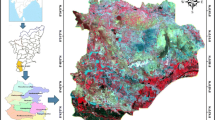Abstract
A direct approach to designing MODFLOW finite difference model is tedious and less intuitive, specifically for complex boundary and initial conditions. Therefore, a MODFLOW model can be developed either using a grid or conceptual model approach. The conceptual model is created using Geographic Information System (GIS) objects including points, arcs and polygons so that it can more accurately represent real world condition. It is a simplified representation of the site to be modelled including the model domain, boundary conditions, sources, sinks and material zones. Advantage of conceptual model is that most of the input can be in terms of physical objects, such as wells, lakes, recharge zones etc which can then be converted to a grid based mathematical model with the help of preprocessor software.
This paper presents the results of a mathematical groundwater model developed for the northern part of Mendha sub-basin in the semi arid region of northeastern Rajasthan, employing conceptual groundwater modelling approach. For this purpose, Groundwater Modelling Software (GMS) was used which supports the MODFLOW-2000 code. For the purpose of modelling the Source/ Sink Coverage, Recharge Coverage, Extraction Coverage, Return Flow Coverage and Soil Coverage were considered. The model was calibrated against the historical and observed water level data for periods 1998 to 2003 and 2003 to 2005 respectively.
The model was calibrated using observed water level data collected during the study period, so that model is capable to producing field measured heads and flow. For the present study historical data of water level is divided into two parts, in the first part of data from year 1998 to 2003 were used for the calibration purpose. In the second part the available field data during year 2003 to 2005 were used for model verification.
The model was run to generate groundwater scenario for a 15 year period from 2006 to 2020 considering the existing rate of groundwater draft and recharge. The water budget predictions indicate a decrease from 349.50 to 222.90 MCM in the groundwater storage system, whereas groundwater abstraction shows an increase from 258.69 to 358.74 MCM per annum. The predicted water table contour maps for the years 2007, 2015 and 2020 have also been generated.
Similar content being viewed by others
References
Anderson, M.P. and Woessner, W.W. (1992) Applied Groundwater Modeling — Simulation of Flow and Advective Transport, Academic Press, San Diego, 381p.
CGWB (2003) Central Ground Water Board, Western Region, Jaipur. Ground Water Year Book, 125p.
CGWB (2005) Central Ground Water Board, Western Region, Jaipur. Ground Water Exploration Report of Rajasthan, 287p.
Ground Water Department, Sikar, Rajasthan (2004) A Reappraisal of ground water resource of Sikar District as on 31.3.2004 (unpublished report), 172p.
Gupta, C.P. and Thangarajan, M. (1990) Management of groundwater resources in India using simulation models. Water Resources Jour., March 1990, pp.34–42.
GEC (1997) Guidelines for assessment of ground water resources, Ground Water Estimation Committee, Ministry of Water Resources, Govt. of India. New Delhi, 107p.
Kresic, N. (1997) Quantitative solutions in hydrogeology and ground water modeling. CRC press LLc, USA, 443p.
McDonald, M.G. and Harbaugh, A.W. (1988) A modular three-dimensional finite difference groundwater flow model. Washington, USGS.
Maidment, D.R. (1993) Handbook of Hydrology. McGraw Hill, New York, pp.102–110.
Nabidi, I.K. (2002) Development of 3-D conceptual hydrogeological model for Lake Navaisha area. WREM. Enschede, ITC, The Netherlands.
Raghunath, H.M. (1988) Ground Water, Wiley Eastern Limited, New Delhi, pp.89–97.
Spitez, K. (1996) A practical guide to groundwater and solute transport modeling. John Wiley and Sons Inc., 238p.
Author information
Authors and Affiliations
Corresponding author
Rights and permissions
About this article
Cite this article
Kushwaha, R.K., Pandit, M.K. & Goyal, R. MODFLOW based groundwater resource evaluation and prediction in Mendha sub-basin, NE Rajasthan. J Geol Soc India 74, 449–458 (2009). https://doi.org/10.1007/s12594-009-0154-1
Received:
Accepted:
Published:
Issue Date:
DOI: https://doi.org/10.1007/s12594-009-0154-1




